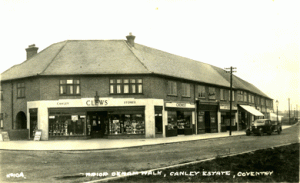Styvechale, Canley and Tile Hill were amongst the last Coventry suburbs to be fully developed in the mid twentieth century. They cover most of the southern boundary of the city. Until the 1930s they had no significant residential or industrial incursions, excepting that of the Standard Works built at Canley during the First World War. The reasons for their long reprieve and the subsequent shape of their development, was a combination of the conservatism of the landed gentry and the foresight of the city council.
Styvechale, was in the hands of the Gregory family since the sixteenth century and remained a rural parish on the edge of the city centre until the start of the 1920s when the War Memorial Park was laid out. Improved access to all three areas was affected with the construction of the Coventry by-pass in the mid to late 1930s, which provided the necessary stimulus to various building schemes. Styvechall hamlet was preserved thanks to a gift to the city by the owners in 1932. Fortunately, Styvechale Common, Canley Ford, the avenue on Kenilworth Road, and various woodland in the Tile Hill area, were also preserved by the purchase of 200 acres of land from Lord Leigh of Stoneleigh by the City Council. Knowing that planning regulations were very loose in those days this was the only way that the Council felt they could control development and preserve significant rural features. The foresight of the council has certainly been to the overall benefit of the ratepayers over the years.
 1. Canley Water Falls c1912 (Waterman)
1. Canley Water Falls c1912 (Waterman)
Very few postcards showing buildings in Edwardian Canley exist so this of Canley Brook. After crossing Watery Lane, seen on page 87 of Volume I, the brook crossed fields where due to the changing ground levels these waterfalls existed. In 1936, the section of the Fletchamstead Highway was commenced from Canley Road to the railway bridge at Fletchamstead and this section of the brook was re-developed, now being under the Highway.
 2. Prior Deram Walk c1939 (Richards)
2. Prior Deram Walk c1939 (Richards)
The late 1930s saw the development of the modern Canley housing estate, when Sherriff Avenue, Prior Deram Walk and the surrounding roads were laid out. The bottom view shows the group of shops on the corner of Prior Deram Walk and D’Aubney Road. Clews Canley Stores and Newsagents has a newsboard outside announcing ‘Britain Warns Hitler’.
3. Torrington Avenue c1939 (Richards) 4. Standard Aero Works c1939 (Richards)
The photographer who took this pictures only had to turn around to take the second view, as they were taken at the same time. They must also have been taken on the same day as the picture of Prior Deram Walk on the previous page, as a newsboard saying ‘Britain Warns Hitler’ is also outside R.C. Blockley’s Newsagents. The next shop is Mrs Arnett’s fried fish saloon, with on the opposite side of Torrington Avenue, Coventry Swaging Company later to become the Torrington Company. Torrington Avenue at this time terminated at Templar Avenue, a footpath continuing past Fletchamstead Hall to Station Avenue at Tile Hill. The bottom view of the Standard Aero Works shows the cycle track on the Fletchamstead Highway not yet surfaced. Although this portion of the Standard Motor Company Works (originally built in 1937 as a ‘Shadow Factory’ to produce aero engines) still exists as part of the Rover Company, the part which was Standard Spares and Service has recently been demolished. This corner of Tile Hill Lane has become yet another superstore. One of the trees, now cut down, can be seen over the factory roof.